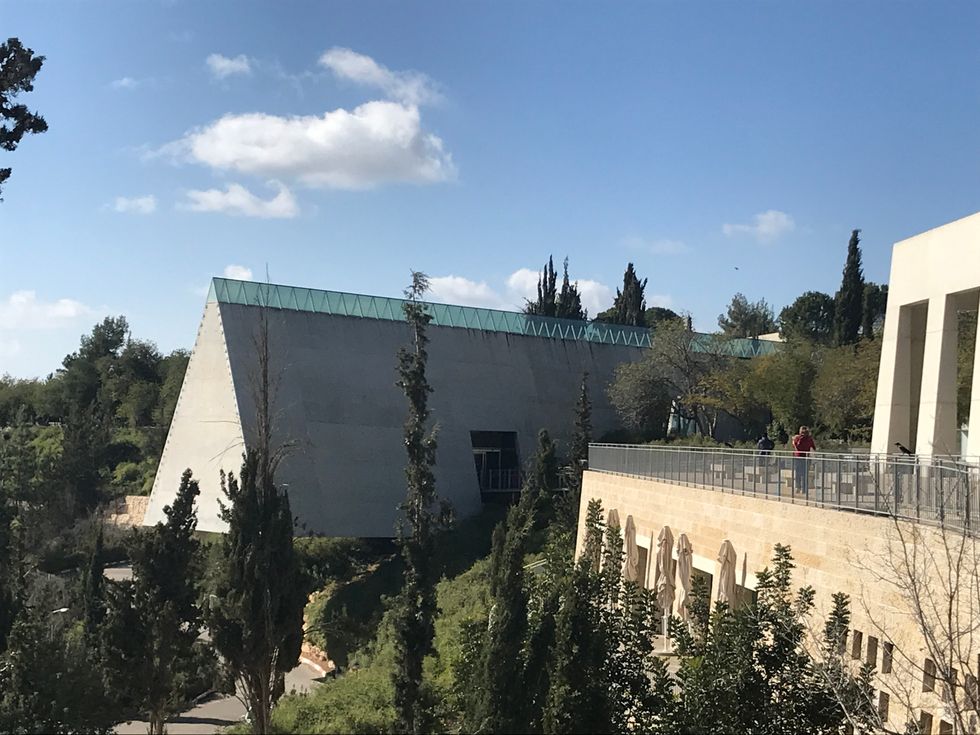This morning, we are going to the Yad Vashem World Holocaust Remembrance Center in Jerusalem. This is no ordinary Holocaust museum, and by the end of our time in the museum, I think I can safely say that we were all quite emotional.
The name of the museum, Yad Vashem, actually has a meaning. In Hebrew, Yad means "hand" or "arm," Va is "and," and Shem is "name." So, literally, Yad Vashem means "hand and name." Why is it called that, you ask? It comes from a psalm in the Old Testament, from when Jews fell into Babylonian captivity.
Their God said to them, "You will lose, o Israel, both sons and daughters. But I will give you an arm (strength) and a name (glory) and your arm and your glory will be more important than sons and daughters." The arm, in this case, also represents a statue of remembrance--a monument. Thus, the name of the Holocaust museum commemorates the fact that though millions of Jewish sons and daughters were lost in the Holocaust, their God will give them a monument and a name.
The architecture of Yad Vashem is brilliant but very sad. From the outside, it looks like an upside-down triangular prism (upside-down in the sense that the prism is wider on top, and the narrow tip of the triangle is on the ground). For the main part of the building, there are no electric lights; instead, there are small windows at the top of the building to let natural light in. There wasn't much natural light, and it was dark--just like how the 1900s were a dark time for Jews.
Inside, you can stand on one end of the prism and see the other end. However, there is no way to walk straight across the building and exist on the other side. Instead, you are kind of involuntarily thrown from side room to side room, as that is the only path through the museum.
This is to symbolize how Jews in the Holocaust did not have the privilege of walking the straight paths of their lives, and how they were thrown around until they ultimately did reach liberation or, unfortunately, did not.
We start at the entrance end of the prism. There is a black and white video that a historian put together; it has small video clips of Jewish people living their lives all throughout Europe. Polish Jews walking in the streets, German Jews playing tag, and a choir of Jewish kids singing. Our guide tells us that most of these kids will never reach adulthood.
We continue walking. The purpose of Yad Vashem, to me, was not to highlight all the pain and suffering--though those topics are unavoidable--but to showcase the resilience of the Jewish people, and what this land means to them. It was in Yad Vashem that I felt the most strong empathy for the case of a Jewish homeland because of how much it moved me.
The first few side rooms of the building gave a lot of historical context. It went back further than any other Holocaust museum I've been to, detailing the rise of anti-Semitism in Europe, country by country. It displayed newspaper clippings of Jews being blamed for every natural, economic, or social disaster. Truly, the Jews were the butt of every joke.
Soon, we walked through the events of World War I and Hitler's rise to power after it. We saw the dehumanization of Jews in cartoons, articles, and mass media. We saw the burning of Jewish books by European college students--college students, just like us.
We saw the rise of the ghettos, with chunks of brick road from the original Warsaw ghetto actually being the floor we walked upon. We saw Jewish uprisings that may have ultimately failed, but were attempted nonetheless--they fought, tooth and nail, just for the line in the history book that said they were not sheeps led to the slaughterhouse.
We saw the construction of death camps and concentration camps. We saw small models of each one, and we were told which path Jews would take upon entering the camp--which steps they would take to their deaths. We read from letters of loved ones who never saw their families again. We saw the mass murders at Babi Yar and read the Yevtushenko poem written in its name.
We saw humanity in the people who helped hide Jews during this time, and we saw the fear inside Nazis, who hid their faces from humanity, so that they could carry out orders. We saw the evil hierarchy of power that was constructed for Nazis to not directly feel guilt. We saw Hitler's "final solution."
We saw humanity, too, in the love and kindness shared among Jews. We saw Jews who, despite being stripped of their clothes and name in exchange for a number, did whatever they could to keep even a sliver of their identity--a small red flower as a sign of femininity, anything. We saw Jews praying together before being executed together. We saw that hope never died.
In the end of our zigzag path through the seemingly straight building, we were led into a circular room with a wide, deep hole in the middle. We looked down and saw the hole dug into Jerusalem stone. We looked up and around, and saw six million books on shelves--for the six million testimonies.
The books were not completely filled yet, but Yad Vashem continues to work on gathering stories and pictures for this purpose. Above the dark hole, there was a smaller circle of pictures. They were religious Jews. They were secular Jews. They were mothers. They were newborns. They were students. They were veterans. They were all Jews who died in the Holocaust, and their pictures were all provided by relatives, friends, or someone they had known--given to the museum to put a face to every name.
This was the last stop in the building, and as we opened the door to leave, we walked out onto a porch that overlooked the entire city of Jerusalem. It was, truly, the light at the end of the dark tunnel.
The idea behind this beautiful view of Jerusalem was that if there had been a Jerusalem--if there had been an Israel--even just ten years before the establishment of the state of Israel, the Holocaust would not have happened, and this museum would not have been needed. This image of Jerusalem--this beautiful, unreachable view--was exactly what Jews needed at the time, and what the Jewish homeland means to so many Jews who make Aliyah to Israel every year.
After we had our emotional walk through the main Yad Vashem building, we went to an adjacent building dedicated to Holocaust research. There we talked with a Holocaust survivor and heard her story. I will be talking about that in the next section--see you there!
- Yad Vashem (@yadvashem) • Instagram photos and videos ›
- Yad Vashem Photo Collections ›
- The Righteous Database ›
- Yad Vashem Holocaust Museum ›
- Yad Vashem (@yadvashem) | Twitter ›
- Yad Vashem - YouTube ›
- Central DB of Shoah Victims' Names ›
- American Society for Yad Vashem – The Holocaust Martyrs' and ... ›
- Yad Vashem. The World Holocaust Remembrance Center | www ... ›
















